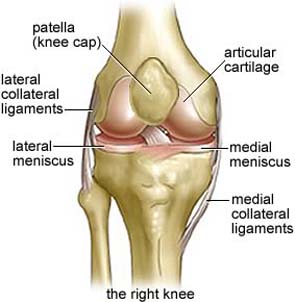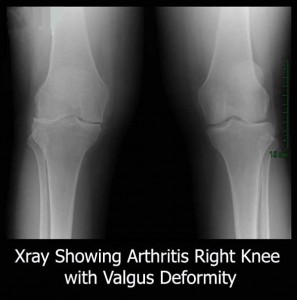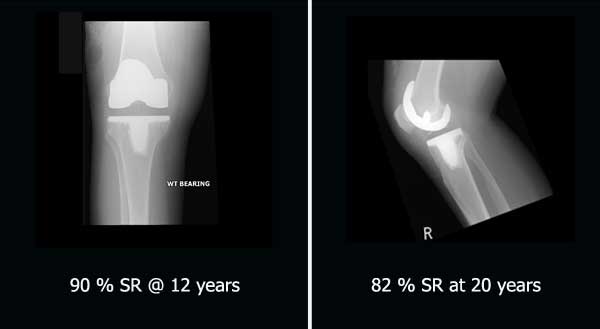Knee Surgery Information for Patients
Introduction
 The knee joint can be regarded as a complex minimally constrained hinge joint, which demonstrates additional rotational and gliding movement. It is made up of three bones; the femur (thigh bone) tibia (shin bone) and the patella (knee cap). The surfaces of all three are covered with smooth articular (hyaline) cartilage allowing free and painless movement. It is a complex joint and a normal knee joint has ligaments both within the knee (anterior and posterior cruciates) and on the inner and outer aspects of the knee (medial and lateral collateral ligaments). This complex of ligaments provides stability for the normal knee joint. Also within the knee are the menisci. There are two menisci, one located on the inner (medial meniscus) and the other on the outer side of the interior of the knee joint (lateral meniscus). They are commonly called cartilages and can be torn as a result of a twisting or rotational injury causing pain or they can tear in association with early degeneration within the knee (wear and tear).
The knee joint can be regarded as a complex minimally constrained hinge joint, which demonstrates additional rotational and gliding movement. It is made up of three bones; the femur (thigh bone) tibia (shin bone) and the patella (knee cap). The surfaces of all three are covered with smooth articular (hyaline) cartilage allowing free and painless movement. It is a complex joint and a normal knee joint has ligaments both within the knee (anterior and posterior cruciates) and on the inner and outer aspects of the knee (medial and lateral collateral ligaments). This complex of ligaments provides stability for the normal knee joint. Also within the knee are the menisci. There are two menisci, one located on the inner (medial meniscus) and the other on the outer side of the interior of the knee joint (lateral meniscus). They are commonly called cartilages and can be torn as a result of a twisting or rotational injury causing pain or they can tear in association with early degeneration within the knee (wear and tear).
 The knee like any other joint can develop changes of wear and tear (arthritis). Arthritis of the knee is a common condition and maybe associated with the wear and tear process of ageing. Arthritis may also develop following trauma. Inflammatory arthritis is a generalised condition and this can affect the knee joint along with other joints and organs of the body.
The knee like any other joint can develop changes of wear and tear (arthritis). Arthritis of the knee is a common condition and maybe associated with the wear and tear process of ageing. Arthritis may also develop following trauma. Inflammatory arthritis is a generalised condition and this can affect the knee joint along with other joints and organs of the body.
When arthritis affects the knee joint, it may affect all or any part of the knee. The wear and tear process may lead to a progressive deformity. If the wear process predominantly affects the outer side of the knee a knock knee deformity will arise (valgus deformity), whereas wear of the inner aspect of the knee will lead to a bow legged (varus) deformity. If a knee replacement is to be performed in the presence of any such deformity, it is important to be aware of these deformities and to correct them at the time of surgery by appropriate soft tissue releases. Such releases can be either on the inner side of the knee for a varus (bow-legged) deformity or on the outer aspect of the knee for a valgus (Knocked-knee) deformity to achieve deformity correction.
When the pain of an arthritic knee joint is sufficiently severe as to limit mobility and affect daily activities and not managed by measures such as analgesia and physical therapy surgery may need to be considered.
Operation
In all conditions of the knee the type of surgery and the type of implant used often affects the result and outcome. The results of such surgery depend upon a variety of factors which your surgeon should discuss with you.
Before major replacement surgery is considered, physical therapy and the cautious use of anti-inflammatory medication maybe of help. Day case surgery in the form of arthroscopy may also be of help in symptomatic patients who have mild but not severe arthritic changes in the knee joint.
The LCS Knee System
